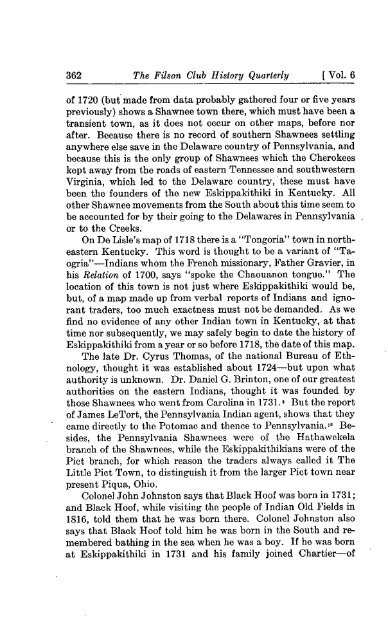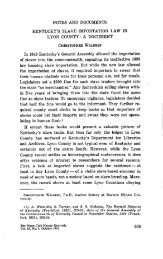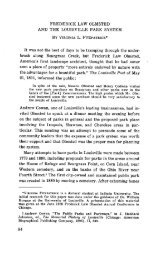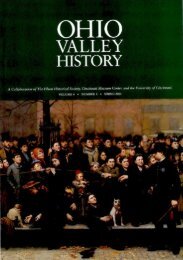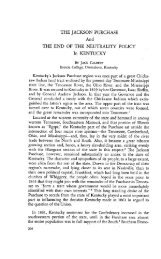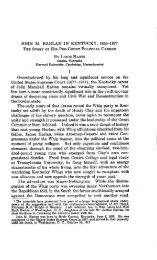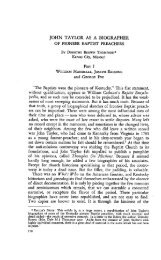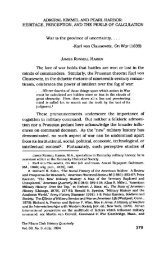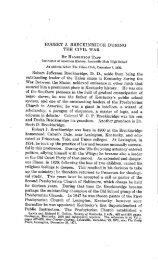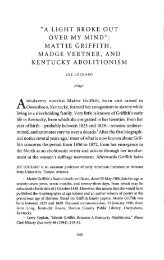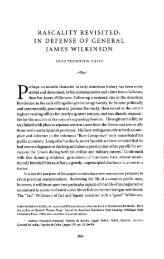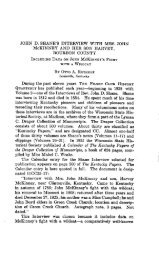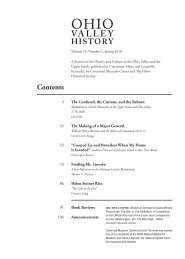Eskippakithiki, The Last Indian Town in Kentucky - The Filson ...
Eskippakithiki, The Last Indian Town in Kentucky - The Filson ...
Eskippakithiki, The Last Indian Town in Kentucky - The Filson ...
You also want an ePaper? Increase the reach of your titles
YUMPU automatically turns print PDFs into web optimized ePapers that Google loves.
362 <strong>The</strong> Fdson Club History Quarterly [ Vol. 6<br />
of 1720 (but'made from data probably gathered four or five years<br />
previously) shows a Shawnee town there, which must have been a<br />
transient town, as it does not occur on other maps, before nor<br />
after. Because there is no record of southern Shawnees settl<strong>in</strong>g<br />
anywhere else save <strong>in</strong> the Delaware country of Pennsylvania, and<br />
because this is the only group of Shawnces which the Cherokees<br />
kept away from the roads of eastern Tennessee and southwestern<br />
Virg<strong>in</strong>ia, which led to the Delaware country, these must have<br />
been the founders of the new <strong>Eskippakithiki</strong> <strong>in</strong> <strong>Kentucky</strong>. All<br />
other Shawnee movements from the South about this time seem to<br />
be accounted for by their go<strong>in</strong>g to the Delawares <strong>in</strong> Pennsylvania ,<br />
or to the Creeks.<br />
On De Lisle's map of 1718 there is a "Tongoria" town <strong>in</strong> northeastern<br />
<strong>Kentucky</strong>. This word is thought to be a variant of "Taogria"--!ndians<br />
whom the French missionary, Father Gravier, <strong>in</strong><br />
his Relation of 1700, says "spoke the Chaouanon tongue." <strong>The</strong><br />
location of this town is not just where <strong>Eskippakithiki</strong> would be,<br />
but, of a map made up from verbal reports of <strong>Indian</strong>s and ignorant<br />
traders, too much exactness must not be demanded. As we<br />
f<strong>in</strong>d no evidence of any other <strong>Indian</strong> town <strong>in</strong> <strong>Kentucky</strong>, at that<br />
time nor subsequently, we may safely beg<strong>in</strong> to date the history of<br />
Estdppakithiki from a year or so before 1718, the date of this map.<br />
<strong>The</strong> late Dr. Cyrus Thomas, of the national Bureau of Ethnology,<br />
thought it was established about 1724--but upon what<br />
authority is unknown. Dr. Daniel G. Br<strong>in</strong>ton, one of our greatest<br />
authorities on the eastern <strong>Indian</strong>s, thought it was founded by<br />
those Shawnees who went from Carol<strong>in</strong>a <strong>in</strong> 1731., But the report<br />
of James LeTort, the Pennsylvania <strong>Indian</strong> agent, shows that they<br />
came directly to the Potomac and thence to Pennsylvania.,° Besides,<br />
the Pennsylvania Shawnees were of the Hathawekela<br />
branch of the Shawnecs, while the <strong>Eskippakithiki</strong>ans were of the<br />
Pict branch, for which reason the traders always called it <strong>The</strong><br />
Little Pict <strong>Town</strong>, to dist<strong>in</strong>guish it from the larger Pict town near<br />
present Piqua, Ohio.<br />
Colonel John Johnston says that Black Hoof was born <strong>in</strong> 1731 ;<br />
and Black Hoof, while visit<strong>in</strong>g the people of <strong>Indian</strong> 01d Fields <strong>in</strong><br />
1816, told them that he was born there. Colonel Johnston also<br />
says that Black Hoof told him he was born <strong>in</strong> the South and remembered<br />
bath<strong>in</strong>g <strong>in</strong> the sea when he was a boy. If he was born<br />
at Eskippakithild <strong>in</strong> 1731 and his family jo<strong>in</strong>ed Chartier--of


